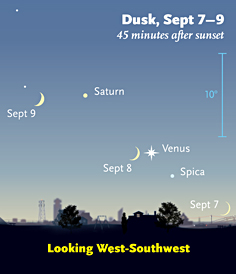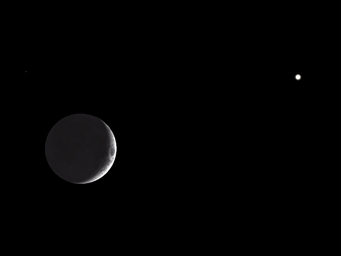September 3, 2013
Contact:
Tony Flanders, Associate Editor, Sky & Telescope
855-638-5388 x2173, [email protected]
Alan MacRobert, Senior Editor, Sky & Telescope
855-638-5388 x2151, [email protected]
| Note to editors/producers: Two publication-quality illustrations are available; click on the thumbnails below. If images don't appear, add ?1=1 to the URL and refresh. |
Soon after the Sun dips below the western horizon on Sunday, September 8th, anyone looking in that direction will see a dramatic sight: a pretty crescent Moon paired closely with the dazzling planet Venus, the "Evening Star."

The Moon and Venus pair dramatically after sunset on September 8th. Click on the image for a larger version, or click here to view a version in HD format.
Sky & Telesope diagram
"This is one you won't want to miss," says Alan MacRobert of Sky & Telescope magazine. "These are the two brightest objects in the nighttime sky."
Start looking for the pair about 30 minutes after sunset. The farther south and east you are in North America, the closer they'll appear. From locations along the East Coast, the they'll be only about 1½° apart — about the width of your index finger at arm's length. By the time darkness falls on the West Coast, the Moon will have edged slightly farther away.
The pairing will look especially dramatic when viewed through binoculars or a backyard telescope at low magnification. Although the celestial duo might seem close together, Venus is actually more than 400 times farther away — just under 100 million miles, compared to about 235,000 miles for the Moon.
In portions of Brazil, Argentina, and Uruguay, the Moon actually covers Venus for a short time, an event that astronomers call an occultation. Viewed from Europe, the Moon will appear below the planet.
Venus shines with a steady, unmistakable gleam. Often called the "Evening Star," it has been lingering above the western horizon after sunset for the past few months, and it will remain in view there through the end of the year. Seen through a telescope, the planet currently shows a tiny, football-shaped (gibbous) disk.

This simulation shows how September 8th's razor-thin crescent Moon, its nightside bathed in earthshine, will appear roughly 2° from brilliant Venus. The pairing will look very dramatic through binoculars or a small telescope. Click on the image for a larger version.
Source: Stellarium
Meanwhile, the Moon is only three days past new, so its crescent will look razor-thin. As the sky darkens, many people will see the dark, left-hand portion of the lunar disk filled in with a ghostly glow known as earthshine. That portion of the Moon's nightside is dimly lit by the light of the nearly-full Earth in the Moon's sky.
The prior evening, September 7th, you might glimpse an even thinner lunar crescent hugging the western horizon to the lower right of Venus. One day afterward, on September 9th, the Moon's somewhat-fatter crescent will be higher up and farther to the left.
Two other celestial treats are lingering nearby. Look to the upper-left of the Moon and Venus, by about the width of your clenched fist at arm's length, to spot the ringed planet Saturn. To the duo's lower-right, not as far away, is the star Spica. Saturn and Spica are much fainter than Venus, so they won't become visible until twilight deepens.
For more skywatching information and astronomy news, visit SkyandTelescope.com or pick up Sky & Telescope, the essential magazine of astronomy since 1941.
Sky Publishing (a New Track Media company) was founded in 1941 by Charles A. Federer Jr. and Helen Spence Federer, the original editors of Sky & Telescope magazine. In addition to Sky & Telescope and SkyandTelescope.com, the company publishes two annuals (Beautiful Universe and SkyWatch), as well as books, star atlases, posters, prints, globes, and other fine astronomy products.
 0
0
Comments
You must be logged in to post a comment.